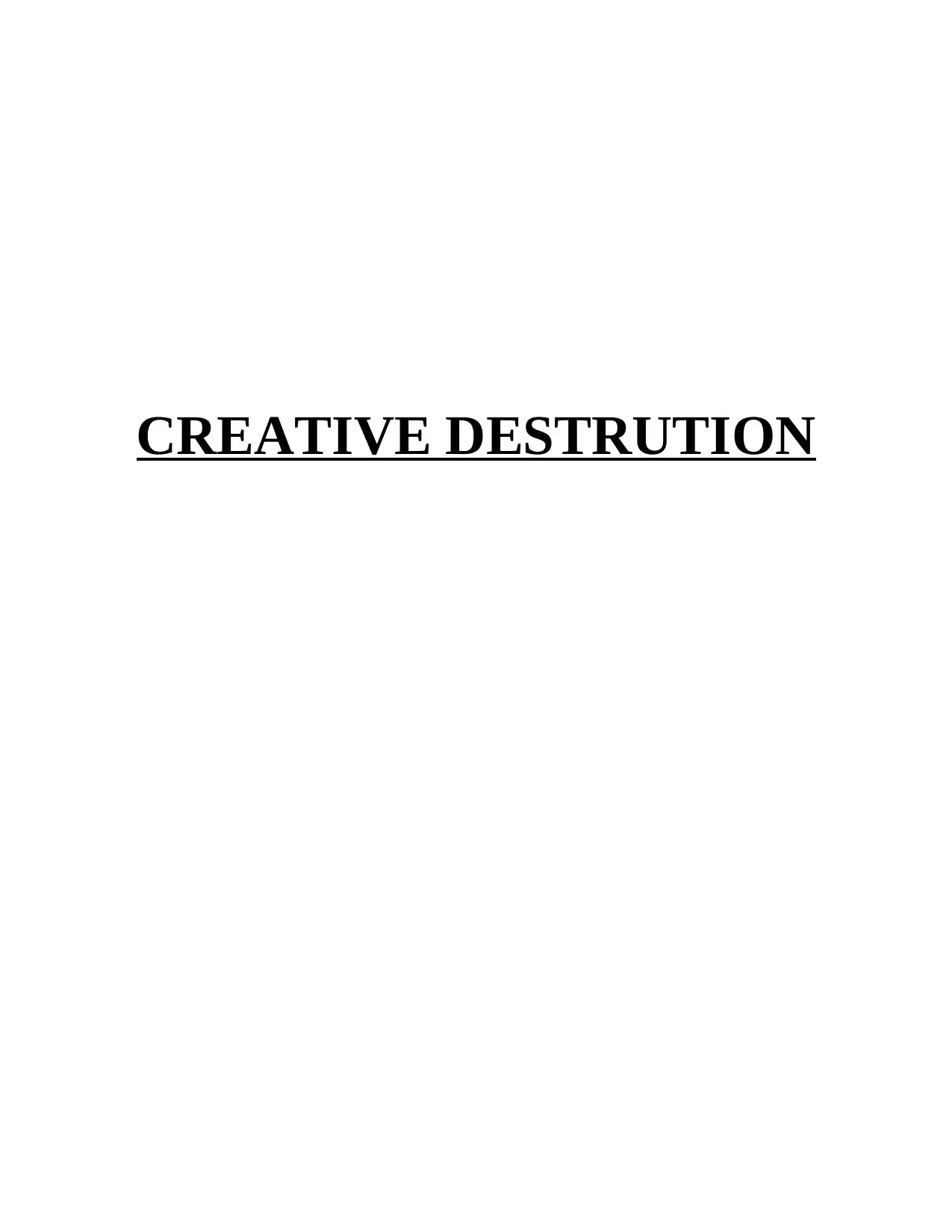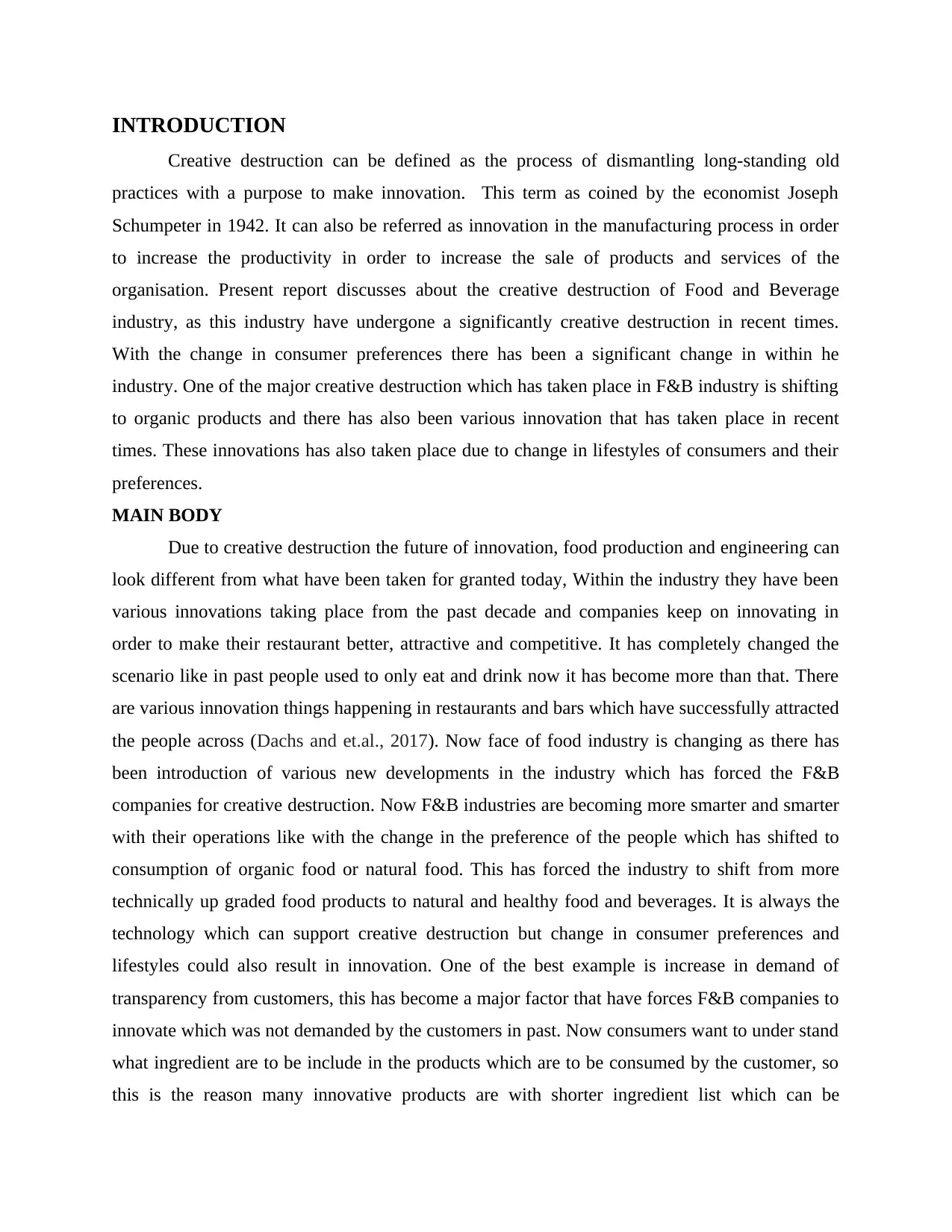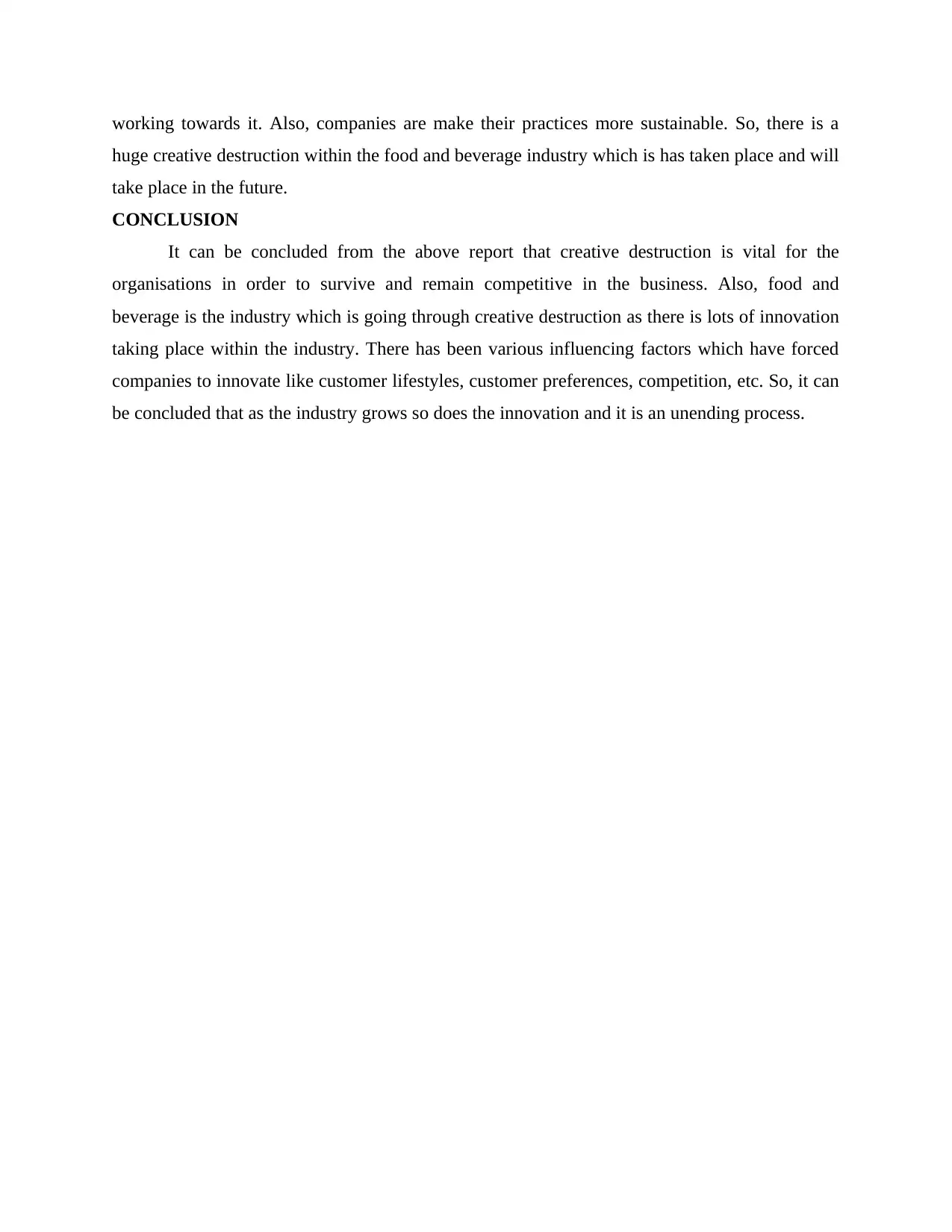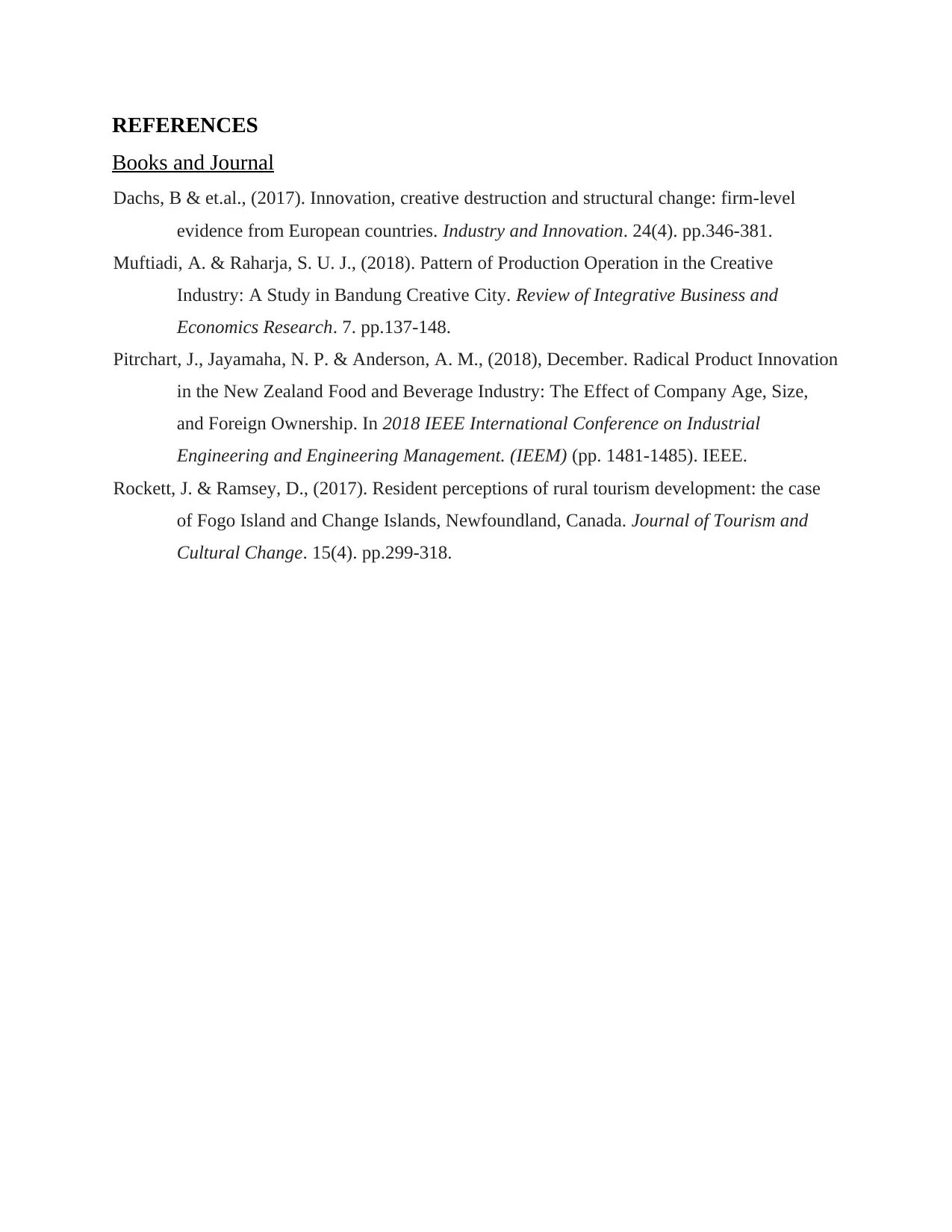Report: Creative Destruction and Innovation in the F&B Industry
VerifiedAdded on 2021/02/21
|6
|1306
|79
Report
AI Summary
This report provides an in-depth analysis of creative destruction within the Food and Beverage (F&B) industry, focusing on the significant transformations driven by innovation and evolving consumer preferences. The introduction defines creative destruction as the process of replacing old practices with innovation, highlighting its impact on the F&B sector. The main body delves into specific examples of creative destruction, such as the shift towards organic products, health and wellness trends, and the increasing demand for transparency from consumers. It examines how technological advancements and changing lifestyles have reshaped the industry, including innovations in restaurant design, flavors, and sustainable practices. The report references several academic sources to support its findings. The conclusion emphasizes the vital role of creative destruction for the F&B industry to remain competitive and responsive to consumer needs, highlighting the ongoing nature of innovation within the sector.

CREATIVE DESTRUTION
Paraphrase This Document
Need a fresh take? Get an instant paraphrase of this document with our AI Paraphraser

TABLE OF CONTENTS
INTRODUCTION...........................................................................................................................3
MAIN BODY...................................................................................................................................3
CONCLUSION................................................................................................................................5
REFERENCES................................................................................................................................6
INTRODUCTION...........................................................................................................................3
MAIN BODY...................................................................................................................................3
CONCLUSION................................................................................................................................5
REFERENCES................................................................................................................................6

INTRODUCTION
Creative destruction can be defined as the process of dismantling long-standing old
practices with a purpose to make innovation. This term as coined by the economist Joseph
Schumpeter in 1942. It can also be referred as innovation in the manufacturing process in order
to increase the productivity in order to increase the sale of products and services of the
organisation. Present report discusses about the creative destruction of Food and Beverage
industry, as this industry have undergone a significantly creative destruction in recent times.
With the change in consumer preferences there has been a significant change in within he
industry. One of the major creative destruction which has taken place in F&B industry is shifting
to organic products and there has also been various innovation that has taken place in recent
times. These innovations has also taken place due to change in lifestyles of consumers and their
preferences.
MAIN BODY
Due to creative destruction the future of innovation, food production and engineering can
look different from what have been taken for granted today, Within the industry they have been
various innovations taking place from the past decade and companies keep on innovating in
order to make their restaurant better, attractive and competitive. It has completely changed the
scenario like in past people used to only eat and drink now it has become more than that. There
are various innovation things happening in restaurants and bars which have successfully attracted
the people across (Dachs and et.al., 2017). Now face of food industry is changing as there has
been introduction of various new developments in the industry which has forced the F&B
companies for creative destruction. Now F&B industries are becoming more smarter and smarter
with their operations like with the change in the preference of the people which has shifted to
consumption of organic food or natural food. This has forced the industry to shift from more
technically up graded food products to natural and healthy food and beverages. It is always the
technology which can support creative destruction but change in consumer preferences and
lifestyles could also result in innovation. One of the best example is increase in demand of
transparency from customers, this has become a major factor that have forces F&B companies to
innovate which was not demanded by the customers in past. Now consumers want to under stand
what ingredient are to be include in the products which are to be consumed by the customer, so
this is the reason many innovative products are with shorter ingredient list which can be
Creative destruction can be defined as the process of dismantling long-standing old
practices with a purpose to make innovation. This term as coined by the economist Joseph
Schumpeter in 1942. It can also be referred as innovation in the manufacturing process in order
to increase the productivity in order to increase the sale of products and services of the
organisation. Present report discusses about the creative destruction of Food and Beverage
industry, as this industry have undergone a significantly creative destruction in recent times.
With the change in consumer preferences there has been a significant change in within he
industry. One of the major creative destruction which has taken place in F&B industry is shifting
to organic products and there has also been various innovation that has taken place in recent
times. These innovations has also taken place due to change in lifestyles of consumers and their
preferences.
MAIN BODY
Due to creative destruction the future of innovation, food production and engineering can
look different from what have been taken for granted today, Within the industry they have been
various innovations taking place from the past decade and companies keep on innovating in
order to make their restaurant better, attractive and competitive. It has completely changed the
scenario like in past people used to only eat and drink now it has become more than that. There
are various innovation things happening in restaurants and bars which have successfully attracted
the people across (Dachs and et.al., 2017). Now face of food industry is changing as there has
been introduction of various new developments in the industry which has forced the F&B
companies for creative destruction. Now F&B industries are becoming more smarter and smarter
with their operations like with the change in the preference of the people which has shifted to
consumption of organic food or natural food. This has forced the industry to shift from more
technically up graded food products to natural and healthy food and beverages. It is always the
technology which can support creative destruction but change in consumer preferences and
lifestyles could also result in innovation. One of the best example is increase in demand of
transparency from customers, this has become a major factor that have forces F&B companies to
innovate which was not demanded by the customers in past. Now consumers want to under stand
what ingredient are to be include in the products which are to be consumed by the customer, so
this is the reason many innovative products are with shorter ingredient list which can be
⊘ This is a preview!⊘
Do you want full access?
Subscribe today to unlock all pages.

Trusted by 1+ million students worldwide

pronounced. Also, consumers are seeking more simple products rather a an outcome of lab
experiment for example organic food products. Now transparency in F&B industry has become a
major factor and is being adopted by many companies MacDonald which are producing products
in front of their customer which is the best example of transparency.
Another innovation which has taken place within the industry is health and wellness
which has also become a major innovative factor in F&B industry across the world. In past 5
years there has been a trend followed by the companies manifested in a clear and clear labels, the
growth of organic which is mainly due to people becoming more health conscious. Now
companies are innovating in such a way that they can promote healthy well-being of people
(Pitrchart, Jayamaha & Anderson, 2018). Many large F&B industries are struggling for growth
as they are unable to produce health of people through their business and now there has been a
change where consumers is choosing their health and healthy products. This has been a major
challenge for F&B companies in promoting health of people and develop an innovative strategies
for it. Restaurants are innovation in the foods which can promote health benefits which has
shifted their focus on consumers preference and even companies are changing their menu as per
the customer preferences (Muftiadi & Raharja, 2018). Companies are also going beyond their old
motto “Good for You” claims and are now innovating in such a way that how can food help the
customers live healthier and longer lives.
At present F&B industry is has been innovating their interior designs and are establishing
the interiors which are eye catching to customers and make customers feel delighted. Restaurants
are becoming more decorative with innovative lighting and most important there innovation are
based on the theme of restaurants. Hotels and restaurants keep on innovating their designs and
make their changes as per the customer lifestyles and trends which are faced in the industry.
Innovations in food and beverage industry does not stop here but goes along the flavours and
spices which are used to prepare a food. Another creative destruction which took place within the
food and beverage industry is improving their flavours and spices by making innovations in
them. Industry has become more creative in adding flavours and species to drinks and food in
order to attract the people and it all depends on the ability of chef and their experiences (Rockett
& Ramsey, 2017). Flavours have become a key factor of innovation and it has also become so
valuable flavours and ingredients forms an important part of business like ingredients and
flavours in soft drinks, ice-creams, food are innovating rapidly F&B industry is continuously
experiment for example organic food products. Now transparency in F&B industry has become a
major factor and is being adopted by many companies MacDonald which are producing products
in front of their customer which is the best example of transparency.
Another innovation which has taken place within the industry is health and wellness
which has also become a major innovative factor in F&B industry across the world. In past 5
years there has been a trend followed by the companies manifested in a clear and clear labels, the
growth of organic which is mainly due to people becoming more health conscious. Now
companies are innovating in such a way that they can promote healthy well-being of people
(Pitrchart, Jayamaha & Anderson, 2018). Many large F&B industries are struggling for growth
as they are unable to produce health of people through their business and now there has been a
change where consumers is choosing their health and healthy products. This has been a major
challenge for F&B companies in promoting health of people and develop an innovative strategies
for it. Restaurants are innovation in the foods which can promote health benefits which has
shifted their focus on consumers preference and even companies are changing their menu as per
the customer preferences (Muftiadi & Raharja, 2018). Companies are also going beyond their old
motto “Good for You” claims and are now innovating in such a way that how can food help the
customers live healthier and longer lives.
At present F&B industry is has been innovating their interior designs and are establishing
the interiors which are eye catching to customers and make customers feel delighted. Restaurants
are becoming more decorative with innovative lighting and most important there innovation are
based on the theme of restaurants. Hotels and restaurants keep on innovating their designs and
make their changes as per the customer lifestyles and trends which are faced in the industry.
Innovations in food and beverage industry does not stop here but goes along the flavours and
spices which are used to prepare a food. Another creative destruction which took place within the
food and beverage industry is improving their flavours and spices by making innovations in
them. Industry has become more creative in adding flavours and species to drinks and food in
order to attract the people and it all depends on the ability of chef and their experiences (Rockett
& Ramsey, 2017). Flavours have become a key factor of innovation and it has also become so
valuable flavours and ingredients forms an important part of business like ingredients and
flavours in soft drinks, ice-creams, food are innovating rapidly F&B industry is continuously
Paraphrase This Document
Need a fresh take? Get an instant paraphrase of this document with our AI Paraphraser

working towards it. Also, companies are make their practices more sustainable. So, there is a
huge creative destruction within the food and beverage industry which is has taken place and will
take place in the future.
CONCLUSION
It can be concluded from the above report that creative destruction is vital for the
organisations in order to survive and remain competitive in the business. Also, food and
beverage is the industry which is going through creative destruction as there is lots of innovation
taking place within the industry. There has been various influencing factors which have forced
companies to innovate like customer lifestyles, customer preferences, competition, etc. So, it can
be concluded that as the industry grows so does the innovation and it is an unending process.
huge creative destruction within the food and beverage industry which is has taken place and will
take place in the future.
CONCLUSION
It can be concluded from the above report that creative destruction is vital for the
organisations in order to survive and remain competitive in the business. Also, food and
beverage is the industry which is going through creative destruction as there is lots of innovation
taking place within the industry. There has been various influencing factors which have forced
companies to innovate like customer lifestyles, customer preferences, competition, etc. So, it can
be concluded that as the industry grows so does the innovation and it is an unending process.

REFERENCES
Books and Journal
Dachs, B & et.al., (2017). Innovation, creative destruction and structural change: firm-level
evidence from European countries. Industry and Innovation. 24(4). pp.346-381.
Muftiadi, A. & Raharja, S. U. J., (2018). Pattern of Production Operation in the Creative
Industry: A Study in Bandung Creative City. Review of Integrative Business and
Economics Research. 7. pp.137-148.
Pitrchart, J., Jayamaha, N. P. & Anderson, A. M., (2018), December. Radical Product Innovation
in the New Zealand Food and Beverage Industry: The Effect of Company Age, Size,
and Foreign Ownership. In 2018 IEEE International Conference on Industrial
Engineering and Engineering Management. (IEEM) (pp. 1481-1485). IEEE.
Rockett, J. & Ramsey, D., (2017). Resident perceptions of rural tourism development: the case
of Fogo Island and Change Islands, Newfoundland, Canada. Journal of Tourism and
Cultural Change. 15(4). pp.299-318.
Books and Journal
Dachs, B & et.al., (2017). Innovation, creative destruction and structural change: firm-level
evidence from European countries. Industry and Innovation. 24(4). pp.346-381.
Muftiadi, A. & Raharja, S. U. J., (2018). Pattern of Production Operation in the Creative
Industry: A Study in Bandung Creative City. Review of Integrative Business and
Economics Research. 7. pp.137-148.
Pitrchart, J., Jayamaha, N. P. & Anderson, A. M., (2018), December. Radical Product Innovation
in the New Zealand Food and Beverage Industry: The Effect of Company Age, Size,
and Foreign Ownership. In 2018 IEEE International Conference on Industrial
Engineering and Engineering Management. (IEEM) (pp. 1481-1485). IEEE.
Rockett, J. & Ramsey, D., (2017). Resident perceptions of rural tourism development: the case
of Fogo Island and Change Islands, Newfoundland, Canada. Journal of Tourism and
Cultural Change. 15(4). pp.299-318.
⊘ This is a preview!⊘
Do you want full access?
Subscribe today to unlock all pages.

Trusted by 1+ million students worldwide
1 out of 6
Related Documents
Your All-in-One AI-Powered Toolkit for Academic Success.
+13062052269
info@desklib.com
Available 24*7 on WhatsApp / Email
![[object Object]](/_next/static/media/star-bottom.7253800d.svg)
Unlock your academic potential
Copyright © 2020–2025 A2Z Services. All Rights Reserved. Developed and managed by ZUCOL.





